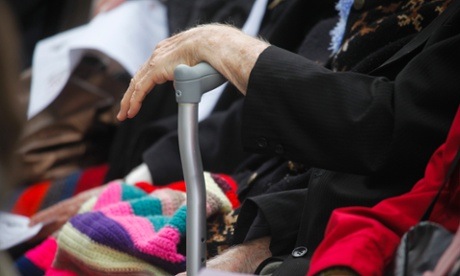
Australian women are living almost four years longer today than they did in 1990, while the life expectancy rose by almost six years for men, a global health study shows.
The average life expectancy was 84 years for women and 79.7 years for men in 2013, the global burden of disease study published in the Lancet on Thursday found.
Chronic kidney disease and Alzheimer’s disease are claiming more Australian lives, with the total number of deaths increasing by 134% and 126% respectively in the 23 years to 2013. The number of deaths from diabetes increased by 101% in the same period.
Diseases associated with old age are the biggest killers of Australians, the study found.
Heart disease was again the biggest killer overall, though the number of deaths dropped from 31,869 to 28,869. Strokes remained the number two leading cause of death.
Suicide, which was the number nine most common cause of death in 1990, dropped out of the top 10 in 2013, and was replaced with pneumonia, a disease mostly associated with old age in Australia.
There was a marked decline in mortality from road injuries, which decreased by 30% and were no longer in the top 10.
An author of the research and a laureate professor at the University of Melbourne, Dr Alan Lopez, said that Australians dying from age-related illnesses was a good thing.
“We should applaud the Australian health system for being increasingly successful at postponing mortality to higher and higher ages,” he said. “It’s a credit to the Australian health system and some bold health policies in Australia, such as the action we have taken on tobacco, and this is a wonderful achievement.”
But if there was one takeaway message from the results, Lopez said he had “six words”: “Don’t smoke. Don’t smoke. Don’t smoke.”
Many of the non-age-related illnesses in the top 10 could be attributed to smoking, Lopez said.
Lung cancer took a greater toll on men in 2013, killing 5,927 of them compared with 3,436 women. Smoking is also a risk factor for strokes and other types of cancer.
“Tobacco is not a lifestyle choice, it’s a conscious choice to expose yourself to something that will kill you,” Lopez said. “We’ve got some strong policies in the tobacco control area but it shows more needs to be done.”
Also of concern was a marked increase in Alzheimer’s disease, he said, which was not occurring just in the elderly but also in older adults.
It was too early to tell why people were developing the disease earlier, he said, but lifestyle-related factors including smoking, diet and alcohol may prove to be factors.
In 2013, Andorra had the longest life expectancy for women (86.7 years) and Qatar had the longest for men (81.2 years). Lesotho had the shortest life expectancy for both women (51.2 years) and men (45.6 years).
A separate study released Thursday from the Australian Institute of Health and Welfare (AIHW) found the number of new cancer cases rose from 47,417 to 123,920 between 1982 and 2014, with significant increases for prostate cancer, bowel cancer, breast cancer and lung cancer.
But this was largely because of the increasing size and age of the population as well as improved diagnosis techniques, AIHW spokesman Justin Harvey said.
Survival from cancer improved significantly, with five-year survival rates from all cancers combined rising from 46% in 1982-1986 to 67% in 2007-2011.
“The overall mortality rate from cancer is expected to drop by 20% from 209 deaths per 100,000 people in 1982 to 168 deaths per 100,000 people in 2014,” Harvey said.
